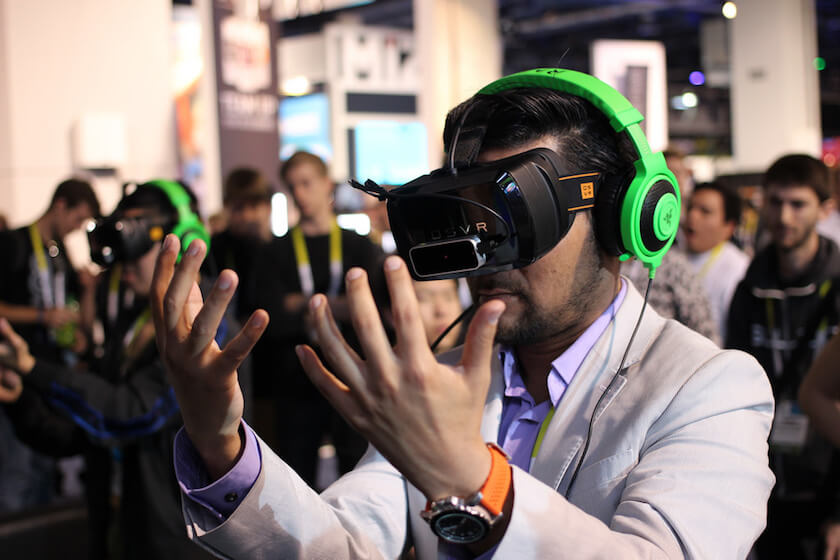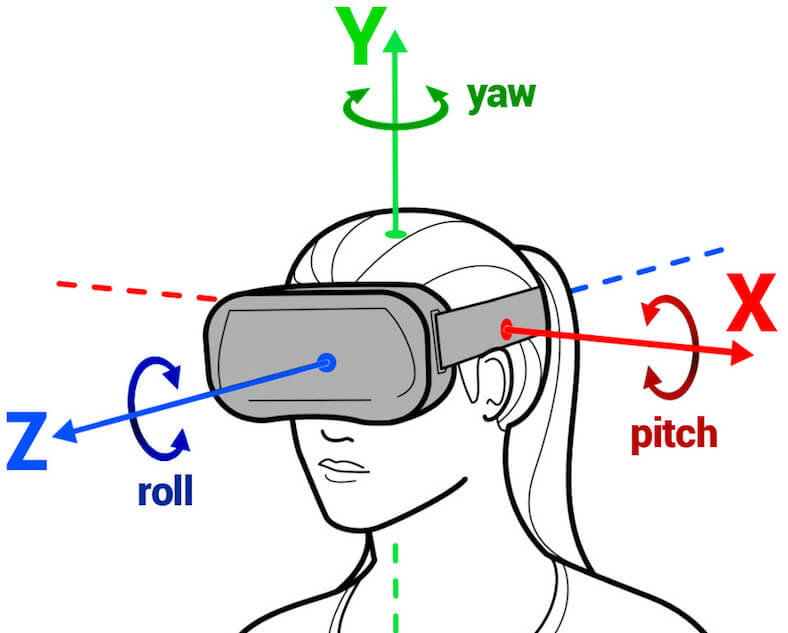Motion tracking is a means through which your physical movements are converted into digital data understandable by software. Quality Motion tracking is an absolute necessity in Virtual Reality.
Improper motion tracking results in a paralysed virtual self, lacking proper co-ordination in movements. The high latency soon affects your mind even causing nausea. However, completely getting rid of motion tracking is out of question. The best you can do without motion tracking is get a 360 view and that’s it.
It is known that for a truly first-class immersive experience putting your entire body into virtual environments is mandatory. Hence there is an obvious need for better technologies and methods to immerse you in virtual worlds.
In this article let’s go through some of these starting from the basics.
What Does Motion Tracking Actually Track?
Take a look at the picture above. This picture illustrates all the possible directions our body can move in 3D space. It is called the six degrees of freedom (6DOF). Any input device to be called a 6DOF-tracking device (like HMDs incase of VR) must track the user in all these dimensions.
Hence for a complete immersive experience both the orientation and position simultaneously are to be tracked by a virtual reality headset.
How Technology Helps In Motion Tracking In VR?
Motion Tracking in virtual reality can be done in several ways. All these techniques can be broadly classified into two categories: optical and non-optical tracking.
Optical tracking makes use of imaging devices to track motion. On the other hand, non-optical tracking makes use of bunch of sensors for motion tracking. Improved accuracy in sensors is currently favoring compact tracking devices.
Optical Methods of Motion Tracking in VR
Optical methods of motion tracking in VR usually use depth-sensing cameras. The reflective markers (i.e. dots of highly reflective materials) are used in combination with the camera system. These cameras capture the markers and map them into a 3D space. These passive reflective markers are placed throughout the body of actors while capturing motion for animation purposes.
However, VR Headsets and controllers equipped have these dots in much less number compared to professional contexts. Hence, they may not always yield accurate results and there are ample chances for incorrect tracking.
The other type of optical markers are computer controlled LEDs called as active markers. These active markers are far more effective and have a higher accuracy compared to passive markers. The LEDs used can either be of any color or flash rapidly in sync to the cameras.
However these optical markers have a major downside too. The user has to put on some kind of energy source to power these LEDs or be connected to the computer, which could disturb the immersive experience. However this technique is used in the Playstation and looks like it is extended to the PSVR headset too.
Microsoft Kinect and Leap Motion
However there are devices like the Microsoft Kinect and Leap motion that are good at motion tracking without the use of any markers. On one hand, Microsoft Kinect uses depth sensing infrared camera and smart software techniques to track subjects. The latest Kinect can track upto 6 individuals at a time.
On the other hand the Leap motion has completely different tracking capabilities. Objects closed to its proximity are scanned in real time at a high resolution and can be used as digital entities. In context of virtual reality, once attached to the HMD it can scan and convert your hand movements into digital data through which you can use your hands to interact with digital objects.
We are still to see highly accurate tracking systems that can track the user in all 6DOF. For consumers, virtual reality is only a “sit-down experience”. Products like the Oculus Rift are currently designed to provide this kind of experience only.
LightHouse Tracking System
The laser-based lighthouse tracking system present in HTC Vive may change this situation. The Lighthouse system can see passive markers on the HTC Vive headset and controllers. As far as optical methods of motion tracking in VR are concerned, the Lighthouse system is something to watch out for right now.
Non-optical methods of motion tracking in VR
The non-optical motion tracking methods have already made their mark in smart phones and tablets. You may not have observed but these are already taking their place in the VR equipment. These are sensors like the magnetometer, gyroscope and accelerometer.
These microscopic sized electromechanical sensors can measure and track movements as they have been doing in smartphones all these years. The accelerometer, for example, measures movement along the XYZ axis. Similarly, the gyroscope can measure rotation along the entire 360 degrees and magnetometer can determine direction of magnetic field, thereby acting as a compass.
These tiny low cost sensors can combine and produce really great motion tracking results in virtual reality importantly at low latency.
GloveOne, Dexmo and Virtuix Omni are notable examples
There are also other non-optical tracking technologies that are close to science fiction. One such approach is direct electro-mechanical body movement sensing. To see this technology in implementation, check out GloveOne.
Marching on similar lines is the use of mechanical exoskeleton systems that can provide haptic feedback and capture motion. The Dexmo exoskeleton we mentioned about in our previous article is one such device that promises to provide feedback, tracking and motion capture.
There is also the Virtuix Omni, a mechanical motion capture treadmill that is a good device for our home and can track you while you are running, crouching and jumping.
The Future of Motion Tracking & VR
The above mentioned optical and non-optical motion tracking techniques (as a combination or individually) are present in motion tracking systems. On the complete other side are technologies like neuroprosthetics, which can help you move your virtual body only with your mind without the need of muscles.
Hence there’s no doubt that we have many existing and potential technologies out there and only time is going to tell the profound impacts they will on Virtual Reality industry.
It’s certain that both the non-optical and optical tracking methods will be made use of even in the upcoming VR headsets. Don’t forget the ultimate goal of VR is to immerse the user completely into a virtual world.
With the fast miniaturization of sensors and electronics you might one day be able to explore the full potential of the VR technology. For now, however, you must make do with the budding virtual reality devices available and believe you are going to experience full VR world while not forgetting to enjoy what’s on offer now.
Image Credits: dsky

